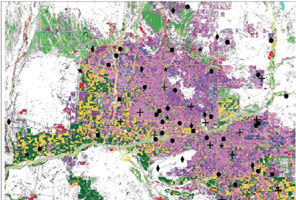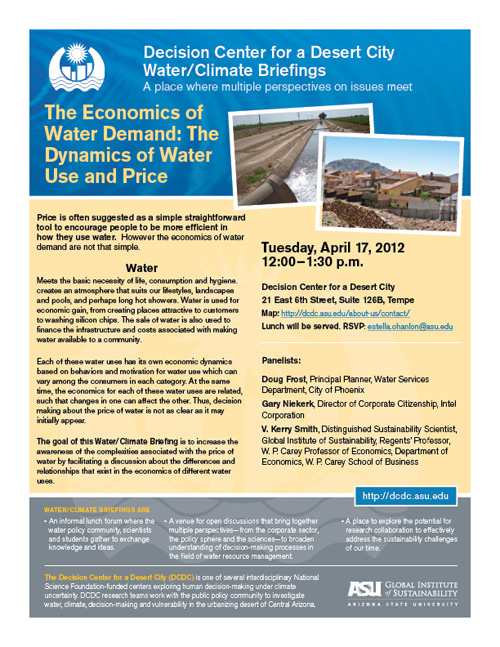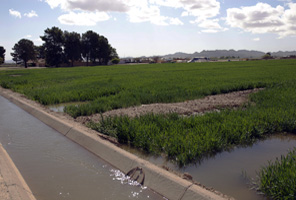Urban Heat Island Research in Phoenix, Arizona: Theoretical Contributions and Policy Applications
Authors: Winston T. L. Chow, Dean Brennan, and Anthony J. Brazel
Department of Engineering, Arizona State University, Mesa, Arizona
School of Geographical Sciences and Urban Planning, Arizona State University, Tempe, Arizona
Abstract
 Over the past 60 years, metropolitan Phoenix, Arizona, has been among the fastest-growing urban areas in the United States, and this rapid urbanization has resulted in an urban heat island (UHI) of substantial size and intensity. During this time, an uncommon amount of UHI-specific research, relative to other cities in North America, occurred within its boundaries. This review investigates the possible reasons and motivations underpinning the large body of work, as well as summarizing specific themes, approaches, and theoretical contributions arising from such study. It is argued that several factors intrinsic to Phoenix were responsible for the prodigious output: strong applied urban climate research partnerships between several agencies (such as the academy, the National Weather Service, private energy firms, and municipal governments); a high-quality, long-standing network of urban meteorological stations allowing for relatively fine spatial resolution of near-surface temperature data; and a high level of public and media interest in the UHI. Three major research themes can be discerned: 1) theoretical contributions from documenting, modeling, and analyzing the physical characteristics of the UHI; 2) interdisciplinary investigation into its biophysical and social consequences; and 3) assessment and evaluation of several UHI mitigation techniques. Also examined herein is the successful implementation of sustainable urban climate policies within the metropolitan area. The authors note the importance of understanding and applying local research results during the policy formation process.
Over the past 60 years, metropolitan Phoenix, Arizona, has been among the fastest-growing urban areas in the United States, and this rapid urbanization has resulted in an urban heat island (UHI) of substantial size and intensity. During this time, an uncommon amount of UHI-specific research, relative to other cities in North America, occurred within its boundaries. This review investigates the possible reasons and motivations underpinning the large body of work, as well as summarizing specific themes, approaches, and theoretical contributions arising from such study. It is argued that several factors intrinsic to Phoenix were responsible for the prodigious output: strong applied urban climate research partnerships between several agencies (such as the academy, the National Weather Service, private energy firms, and municipal governments); a high-quality, long-standing network of urban meteorological stations allowing for relatively fine spatial resolution of near-surface temperature data; and a high level of public and media interest in the UHI. Three major research themes can be discerned: 1) theoretical contributions from documenting, modeling, and analyzing the physical characteristics of the UHI; 2) interdisciplinary investigation into its biophysical and social consequences; and 3) assessment and evaluation of several UHI mitigation techniques. Also examined herein is the successful implementation of sustainable urban climate policies within the metropolitan area. The authors note the importance of understanding and applying local research results during the policy formation process.
Chow, Winston T. L., Dean Brennan, Anthony J. Brazel, 2012: Urban Heat Island Research in Phoenix, Arizona: Theoretical Contributions and Policy Applications. Bull. Amer. Meteor. Soc., 93, 517–530.
doi: http://dx.doi.org/10.1175/BAMS-D-11-00011.1


 Over the past 60 years, metropolitan Phoenix, Arizona, has been among the fastest-growing urban areas in the United States, and this rapid urbanization has resulted in an urban heat island (UHI) of substantial size and intensity. During this time, an uncommon amount of UHI-specific research, relative to other cities in North America, occurred within its boundaries. This review investigates the possible reasons and motivations underpinning the large body of work, as well as summarizing specific themes, approaches, and theoretical contributions arising from such study. It is argued that several factors intrinsic to Phoenix were responsible for the prodigious output: strong applied urban climate research partnerships between several agencies (such as the academy, the National Weather Service, private energy firms, and municipal governments); a high-quality, long-standing network of urban meteorological stations allowing for relatively fine spatial resolution of near-surface temperature data; and a high level of public and media interest in the UHI. Three major research themes can be discerned: 1) theoretical contributions from documenting, modeling, and analyzing the physical characteristics of the UHI; 2) interdisciplinary investigation into its biophysical and social consequences; and 3) assessment and evaluation of several UHI mitigation techniques. Also examined herein is the successful implementation of sustainable urban climate policies within the metropolitan area. The authors note the importance of understanding and applying local research results during the policy formation process.
Over the past 60 years, metropolitan Phoenix, Arizona, has been among the fastest-growing urban areas in the United States, and this rapid urbanization has resulted in an urban heat island (UHI) of substantial size and intensity. During this time, an uncommon amount of UHI-specific research, relative to other cities in North America, occurred within its boundaries. This review investigates the possible reasons and motivations underpinning the large body of work, as well as summarizing specific themes, approaches, and theoretical contributions arising from such study. It is argued that several factors intrinsic to Phoenix were responsible for the prodigious output: strong applied urban climate research partnerships between several agencies (such as the academy, the National Weather Service, private energy firms, and municipal governments); a high-quality, long-standing network of urban meteorological stations allowing for relatively fine spatial resolution of near-surface temperature data; and a high level of public and media interest in the UHI. Three major research themes can be discerned: 1) theoretical contributions from documenting, modeling, and analyzing the physical characteristics of the UHI; 2) interdisciplinary investigation into its biophysical and social consequences; and 3) assessment and evaluation of several UHI mitigation techniques. Also examined herein is the successful implementation of sustainable urban climate policies within the metropolitan area. The authors note the importance of understanding and applying local research results during the policy formation process. However, the economics of water demand are not that simple. Water is used for many purposes. Water is used to meet the basic necessity of life, consumption and hygiene. Water is used to create an atmosphere that suits our lifestyles, landscapes and pools, and perhaps long hot showers. Water is used for economic gain, from creating places attractive to customers to washing silicon chips. The sale of water is also used to finance the infrastructure and costs associated with making water available to a community. Each of these water uses has its own economic dynamics based on behaviors and motivation for water use which can vary among the consumers in each category. At the same time, the economics for each of these water uses are related, changes in one can affect the other. Thus, decision making about the price of water is not as clear as it may initially appear. The goal of this climate briefing is to increase the awareness of the complexities associated with the price of water by facilitating a discussion about the differences and relationships that exist in the economics of different water uses.
However, the economics of water demand are not that simple. Water is used for many purposes. Water is used to meet the basic necessity of life, consumption and hygiene. Water is used to create an atmosphere that suits our lifestyles, landscapes and pools, and perhaps long hot showers. Water is used for economic gain, from creating places attractive to customers to washing silicon chips. The sale of water is also used to finance the infrastructure and costs associated with making water available to a community. Each of these water uses has its own economic dynamics based on behaviors and motivation for water use which can vary among the consumers in each category. At the same time, the economics for each of these water uses are related, changes in one can affect the other. Thus, decision making about the price of water is not as clear as it may initially appear. The goal of this climate briefing is to increase the awareness of the complexities associated with the price of water by facilitating a discussion about the differences and relationships that exist in the economics of different water uses.  The Southwest Climate Alliance [SWCA] welcomes your comments on a DRAFT version of the “Assessment of Climate Change in the Southwest United States: A Technical Report Prepared for the U.S. National Climate Assessment”.
The Southwest Climate Alliance [SWCA] welcomes your comments on a DRAFT version of the “Assessment of Climate Change in the Southwest United States: A Technical Report Prepared for the U.S. National Climate Assessment”.